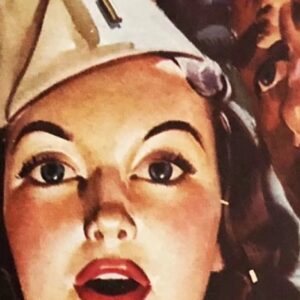It was an introvert’s paradise.
Two weeks after Fidel Castro forced Fulgencio Batista from power in 1959, Justin Gleichauf found himself as the one and only employee of the new CIA operation in Miami. Part of the Domestic Contacts Division of the Directorate of Intelligence, the CIA field office (meaning Gleichauf) was tasked with monitoring and reporting on developments in Cuba.
Gleichauf missed the fighting in the Second World War because he was too underweight for combat action (he was the water boy in college at Notre Dame because he was so skinny). Instead, he served as a technical advisor in the Office of Price Administration and on the Board of Economic Warfare. In. 1950, he joined the CIA, and was assigned to an office that debriefed American professors and businessmen who had just returned from trips to Europe. During the Hungarian revolution in 1956, Gleichauf directed the interrogations of Hungarian rebels who came to the US after fighting Soviet troops.
When he first got to Miami, the first wave of exiles had already arrived, and he set out to learn what government agency was doing what with the new Miami residents. According to Gleichauf, thirteen different federal agencies were working the problem, including the INS; Border Patrol; Customs; the Coast Guard; the State Department; the Department of Health, Education, and Welfare (HEW); FBI; and Army, Navy, and Air Force intelligence (along with a myriad of local law enforcement agencies).
And now the CIA.
At this time, the US government still hadn’t decided what it was going to do about the new regime in Cuba. The US intelligence community had very little information about what was happening there, so Gleichauf collected as much open-source intelligence as he could, like newspapers, magazines, and any other printed material that might have relevant information. This open-source sweep also included Granma, the official newspaper of the Cuban Communist Party, and Verde Olivo, which gave some insight into the Cuban military.
To attract new contacts, he listed his CIA phone number in the telephone book and handed out business cards with his home number. The results were mixed. For every solid lead, Gleichauf explained, there was “a motley collection
of weirdos,” and opportunists who were looking for a way to earn some money from the US government. There were also “lots of would-be Mata Haris, eager to do anything for the cause,” and American mercenaries, who thought Cuba would be a quick and easy way to get glory and riches. Gleichauf consistently tried to warn them off, with limited success.
There were also Castro sympathizers in Miami:
A brick was thrown through the windshield of my car parked outside the house, and my wife received a number of threatening calls along the lines of “. . . [x-date] will be a day that you and your family will never forget . . .” I received a barrage of late-night phone calls, with the caller remaining silent while I answered. I memorized Spanish insults, which I directed at Fidel via the open line. The calls eventually dwindled.
Article continues after advertisement
With so many exiles entering Miami at that time, the CIA finally realized Gleichauf could not do this all by himself, so it beefed up his office’s staffing. To four. The new additions were one air force and two army intelligence officers. Thankfully, they all spoke Spanish.
In the meantime, the government had finally figured out how it was going to react to Fidel Castro: he had to go. The CIA was working on multiple different operational plans against the new Cuban government. One of these involved air-dropping supplies to resistance forces still in Cuba. In late September 1960, the CIA made its first airdrop of supplies to rebels in Oriente Province (enough for one hundred soldiers). The operation, however, did not go as intended. Instead of supplying rebel forces fighting Castro, the airdrop landed seven miles from where it was expected—right into the hands of the Cuban revolutionary militia the arms were meant to be used against.
And this wouldn’t be the last time something like this went awry. Richard Bissell, the CIA Deputy Director of Plans, lamented, “We never got to first base in Cuba in building an underground organization. . . . We only had one [supply drop] where we were reasonably sure that the people the supplies were intended for actually got them.”
Then there was the story you might already have heard of—the CIA’s use of the mob against Castro.
The Mafia was motivated. Before Fidel Castro came to power, Havana had been “the empress city of organized crime,” and a “free port for the mob.” Havana was the main tourist destination in the 1950s, and people came there from all over for the gorgeous weather, the beaches, the gambling, and the bordellos. Even tourists from Miami headed south for activities forbidden at home.
Batista was a supporter of this world, at least for the right price (he received serious kickbacks for his protection). Now he was gone, replaced by a regime that was taking it all away.
The Mafia could not find a way to control Fidel Castro, which meant he had to go. It was nothing personal, just business.
In August 1960, Bissell approached the CIA’s Office of Security to see if they had any assets that “may assist in a sensitive mission requiring gangster-type action. The mission target was Fidel Castro.” The CIA had used a man named Robert Maheu in the past for some of their shadier operations. A former special agent in the FBI, Maheu left the Bureau and opened a private investigation office in Washington, DC, in 1956. He was what was known as a “cut-out,” a middleman, or someone that allowed the Agency to maintain distance from these kinds of things. According to CIA documents, “over the years he [had] been intimately involved in providing support for some of the Agency’s more sensitive operations.” He had contacts in the underworld and would be the person who insulated the CIA from any direct contact with the mob.
Maheu reached out to Johnny Roselli, whom he had met on more than one occasion in Las Vegas. Roselli would eventually link Maheu (and the CIA) with Momo Salvatore “Sam” Giancana and Santo Trafficante Jr., two men, incidentally, on the list of the attorney general’s ten most-wanted. Trafficante was the head of the Mafia’s Cuban operations, and Giancana was the chief of the Chicago branch of the Mafia and considered the successor to Al Capone. Together, Roselli and Giancana had controlled a massive Mafia empire, reportedly larger than the organization run by the five families of the New York Cosa Nostra—combined.
Maheu had been authorized to offer the mobsters $150,000 for the job, but they declined. They would do it for free. Why? Well, for one, they stood to make far more money if Castro was removed from power, and they could restart their gambling interests in Cuba. Also, they likely assumed helping the US government in such a way could pay off later if they found themselves in, say, legal trouble.
In September 1960, Maheu met up with Johnny and Sam at the Boom Boom Room at the Fontainebleau Hotel in Miami. The men discussed a variety of options for taking out Castro. The CIA was originally thinking along the lines of a “typical, gangland-style killing in which Castro would be gunned down,” but Giancana said absolutely no to the use of firearms. He argued that no one could be recruited to do this kind of job, “because the chance of survival and escape would be negligible.”
Instead, the mobsters suggested the use of a poison pill. Giancana said he knew a guy, whom he identified only as “Joe” (it was Trafficante), who would serve as a courier to Cuba and could make arrangements there to get the pill into Castro’s drink. The individual who could get close to Castro in Cuba was Juan Orta, who was described as a “disaffected Cuban official with access to Castro and presumably of a sort that would enable him to surreptitiously poison Castro.” According to Roselli and Giancana, Orta had once received kickbacks from gambling profits, and now that that was gone, “he needed the money.” Orta was, at that time, the office chief and director general of the office of the prime minister, Fidel Castro.
After Maheu reported back to the Agency, the chief of the CIA’s Technical Services Division (TSD) was asked to develop a pill that “had the elements of rapid solubility, high lethal content, and little or no traceability.” The poison itself had to be “stable, soluble, safe to handle, undetectable, not immediately acting, and with a firmly predictable end result.” Botulin toxin met all those requirements and could be made into a pill. Six of these were produced and tested.
And they didn’t work.
When they were dropped in water, they didn’t even disintegrate, let alone dissolve completely, with “little to no traceability.” The TSD tried again, and successfully made a new batch that “met the requirement for solubility.” But would they kill someone?
No.
Guinea pigs were acquired for the test, but when the TSD tested the pills on the poor animals, they were found to be “ineffective.”
Well, that didn’t work. Perhaps we should scrap this idea and move on to plan B?
No.
Roselli was given the useless pills and passed them along to Trafficante, who said they had then been delivered to Orta in Cuba. A 1966 CIA document states that, after several weeks of aborted attempts, Orta “apparently got cold feet and asked out of the assignment.” But by 1967, the CIA knew the real story: Orta had lost his position in the prime minister’s office in January 1961, while planning for the operation was still in full swing in Washington and Miami. Did Roselli, Giancana, and Trafficante know this? According to the CIA, yes. So why did they say they could deliver when clearly they knew they couldn’t? Only the three of them truly know, but one could surmise that they hoped to curry favor with the government by showing they’d tried.
___________________________________


















